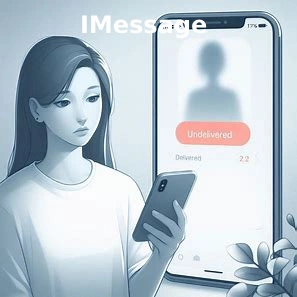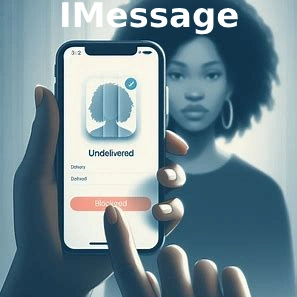Have you ever sent a message on iMessage and wondered why you’re not getting a response? The thought of being blocked can be confusing and stressful. Apple’s privacy features don’t let you know if someone has blocked you, but there are clues you can pick up on. This guide will walk you through everything you need to know about recognizing the signs of being blocked on iMessage, while also helping you handle the situation gracefully.
In this comprehensive guide, we’ll cover how iMessage blocking works, the signs to look for, and common misunderstandings that can occur. We’ll also provide tips on how to proceed if you’ve been blocked and answer frequently asked questions about the topic. Whether you’re dealing with a friend, family member, or someone else, this information will help you navigate the situation with clarity and respect.
How Does Blocking Work on iMessage?
What Happens When Someone Blocks You?
When someone blocks your number on iMessage, they’re essentially cutting off communication with you through this platform. Here’s what happens:
- Messages won’t go through: Messages you send won’t show the usual “Delivered” status beneath them. Instead, they might just hang in the conversation as if unsent.
- Calls are blocked: If you try to call the person, your call will go straight to voicemail after one ring or less. The person won’t receive any notification of your attempt to call.
- No notifications for you: Apple does not notify you that you’ve been blocked, preserving the privacy of the person who blocked you.
This seamless approach ensures that the blocking is quiet and doesn’t cause confrontation.
Why Do People Block Others on iMessage?
Blocking can happen for a variety of reasons, depending on the nature of the relationship. Common reasons include:
- Personal Boundaries: Someone might block you to take space or limit communication for personal reasons.
- Avoiding Conflict: They may want to avoid difficult conversations or potential arguments.
- Spam or Unwanted Contact: Blocking can stop harassment, spam messages, or annoying texts from persistent contacts.
- Temporary Reasons: Sometimes people block others temporarily to focus on themselves or other matters.
While it’s natural to feel upset or confused, try to understand that this action is often about the other person’s needs and not necessarily a reflection of you.

Signs You May Be Blocked
Recognizing the signs of being blocked can save you from unnecessary worry or overthinking. Here are the most common indicators:
Message Delivery Changes
Messages sent through iMessage behave differently when you’re blocked:
- No “Delivered” or “Read” Status: Normally, when you send an iMessage, you’ll see a “Delivered” status below the text. If this doesn’t appear after a reasonable time, it’s a potential sign of being blocked.
- Switch from Blue to Green Bubbles: If your iMessages (blue bubbles) suddenly turn into regular SMS texts (green bubbles), it could mean the person blocked you or switched to a non-Apple device. Check for other signs to confirm.
Call Behavior on a Blocked Number
Blocked calls exhibit the following behaviors:
- Straight to Voicemail: When you call, it will ring once or not at all before going to voicemail. The recipient won’t receive a notification about your call.
- No Response to Multiple Calls: If this pattern persists over time, it’s likely that you’ve been blocked.
Differences Between iMessage and SMS
When blocked, iMessages will not deliver, and you won’t see the usual blue bubble. However, SMS might still show as “Sent,” but that doesn’t mean the recipient got it.
Other Signs
- Lack of Social Media Activity: If the person is also unresponsive or inactive on other platforms, it could signal a broader issue, not just blocking.
- Mutual Friends or Connections: Sometimes, mutual friends may notice if the person has been unavailable or withdrawn recently.
Testing the Block (Without Invading Privacy)
If you suspect someone has blocked you, there are subtle ways to confirm it without being invasive or persistent.
Sending Messages to Check
Try sending a neutral message, like “Hey, just checking in.” Observe the response:
- No “Delivered” status: This is often the first sign of being blocked.
- Green Bubbles: If messages switch to SMS, it’s a clue, but not definitive proof.
Checking Call Response
Place a call to the person. Here’s what to note:
- Voicemail Behavior: Calls that ring once and go to voicemail consistently might indicate blocking.
- No Callback or Response: If the person doesn’t return your calls, it strengthens the suspicion.
Using Other Communication Methods
If iMessage and calls don’t work, try reaching out via:
- Email: A polite, brief email can help clarify if they’re available.
- Social Media: If appropriate, send a message through a social media platform they use.
- Mutual Friends: A mutual friend might provide insight into whether they’re okay.
Avoid Overstepping
Respect the person’s space and avoid excessive attempts to reach them. Overcommunication can make the situation worse and strain the relationship further.
If you want to read more about technology, visit our Website’s Tech Section.
Common Misunderstandings
Before jumping to conclusions, it’s important to consider other explanations for the lack of communication.
Network Issues vs. Being Blocked
Sometimes, network problems can mimic the signs of being blocked. For example:
- No Signal: The recipient might be in a location with poor network connectivity.
- Server Issues: Apple’s iMessage servers occasionally experience downtime, delaying message delivery.
When DND (Do Not Disturb) Looks Like Blocking
If the person has their phone set to Do Not Disturb mode:
- Messages might still deliver, but the recipient won’t see them immediately.
- Calls might bypass DND if marked as “Emergency” in their settings.
Temporary Unavailability
They might have turned off their phone, switched devices, or lost access to their iMessage account temporarily.
Learn more about Apple’s Do Not Disturb feature and how it works.
How to Handle Being Blocked
Respecting Boundaries
If someone has blocked you, it’s important to respect their decision. While it’s natural to feel upset, remember:
- Blocking Is a Personal Choice: The decision to block is about their needs, not necessarily about you.
- Avoid Persistent Contact: Repeated attempts to reach them can worsen the situation and harm your relationship.
Moving Forward When Blocked
Here’s how to cope and move on:
- Focus on Other Relationships: Spend time with friends or family who value your connection.
- Practice Self-Care: Reflect on the situation and focus on activities that bring you joy.
- Seek Clarity When Possible: If you’re unsure why you’ve been blocked, wait for an appropriate time to ask politely.

Frequently Asked Questions
Can I Unblock Myself?
No, only the person who blocked you can unblock you. It’s a feature designed to give control to the user.
What’s the Difference Between Blocking and Silence Notifications?
- Blocking: Stops all communication, including messages and calls.
- Silence Notifications: The person still receives your messages and calls but without alerts.
How Do I Know It’s Not a Network Problem?
If the issue persists over several days, it’s less likely to be a network problem. Consistent signs, like undelivered messages and calls going to voicemail, suggest blocking.
Does Green Bubble Always Mean I’m Blocked?
Not necessarily. A green bubble could mean the recipient’s iMessage is turned off, their phone isn’t connected to the internet, or they’ve switched to a non-Apple device.
Can Someone Block Me Without Me Knowing?
Yes, blocking on iMessage is completely silent. You won’t receive any notification or alert.
Conclusion
Navigating the uncertainty of being blocked on iMessage can be tricky, but understanding the signs and respecting boundaries is key. Pay attention to delivery statuses, call behavior, and other clues before jumping to conclusions. Always remember that blocking is often a personal choice that reflects someone else’s boundaries, not necessarily your actions. If you suspect you’ve been blocked, it’s best to respect the decision, give the person space, and focus on maintaining your own well-being.
Ultimately, clear communication and patience are essential for resolving misunderstandings and maintaining healthy relationships.




